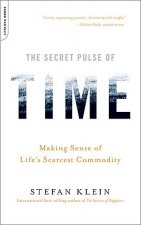
Kód: 01839791
New Doppler Effect
Autor Florian Ion Petrescu
The Doppler effect (or Doppler shift), named after Austrian physicist Christian Doppler who proposed it in 1842 in Prague, is the change in frequency of a wave for an observer moving relative to the source of the wave. It is commo ... celý popis
- Jazyk:
 Angličtina
Angličtina - Väzba: Brožovaná
- Počet strán: 82
Nakladateľ: Books on Demand, 2012
- Viac informácií o knihe

Mohlo by sa vám tiež páčiť
-

Learning Articulate Storyline
58.55 € -

E-Life after the Dot Com Bust
70.22 € -

Little Maid of Ticonderoga
47.59 € -

Beating the Fascists?
62.20 € -

Fortschritte der Chemie Organischer Naturstoffe / Progress in the Chemistry of Organic Natural Products / Progres dans la Chimie des Substances Organi
76.41 € -

1982 Law of the Sea Convention at 30
159.73 € -

new Spanish and English dictionary
38.76 €
Darujte túto knihu ešte dnes
- Objednajte knihu a vyberte Zaslať ako darček.
- Obratom obdržíte darovací poukaz na knihu, ktorý môžete ihneď odovzdať obdarovanému.
- Knihu zašleme na adresu obdarovaného, o nič sa nestaráte.
Viac informácií o knihe New Doppler Effect
Nákupom získate 40 bodov
 Anotácia knihy
Anotácia knihy
The Doppler effect (or Doppler shift), named after Austrian physicist Christian Doppler who proposed it in 1842 in Prague, is the change in frequency of a wave for an observer moving relative to the source of the wave. It is commonly heard when a vehicle sounding a siren or horn approaches, passes, and recedes from an observer. The received frequency is higher (compared to the emitted frequency) during the approach, it is identical at the instant of passing by, and it is lower during the recession.The relative changes in frequency can be explained as follows. When the source of the waves is moving toward the observer, each successive wave crest is emitted from a position closer to the observer than the previous wave. Therefore each wave takes slightly less time to reach the observer than the previous wave. Therefore the time between the arrival of successive wave crests at the observer is reduced, causing an increase in the frequency. While they are travelling, the distance between successive wave fronts is reduced; so the waves \"bunch together\". Conversely, if the source of waves is moving away from the observer, each wave is emitted from a position farther from the observer than the previous wave, so the arrival time between successive waves is increased, reducing the frequency. The distance between successive wave fronts is increased, so the waves "spread out".For waves that propagate in a medium, such as sound waves, the velocity of the observer and of the source is relative to the medium in which the waves are transmitted. The total Doppler Effect may therefore result from motion of the source, motion of the observer, or motion of the medium. Each of these effects is analyzed separately. For waves which do not require a medium, such as light or gravity in general relativity, only the relative difference in velocity between the observer and the source needs to be considered.
 Parametre knihy
Parametre knihy
Zaradenie knihy Knihy po anglicky Mathematics & science Science: general issues
15.92 €
- Celý názov: New Doppler Effect
- Autor: Florian Ion Petrescu
- Jazyk:
 Angličtina
Angličtina - Väzba: Brožovaná
- Počet strán: 82
- EAN: 9783848229901
- ISBN: 3848229900
- ID: 01839791
- Nakladateľ: Books on Demand
- Hmotnosť: 91 g
- Rozmery: 203 × 127 × 4 mm
- Dátum vydania: 05. November 2012
Obľúbené z iného súdka
-

Science of Interstellar
24.14 € -6 % -

Secret Pulse of Time
20.08 € -12 % -

Life of Perfume
17.65 € -

The Demon-Haunted World
17.75 € -10 % -

Short History of Nearly Everything: Special Illustrated Edit
32.57 € -9 % -

Cartoon Guide to Physics
16.43 € -23 % -

Cave Art and Climate Change
16.23 € -

How the Mind Works
18.66 € -19 % -

World as I See it
12.98 € -1 % -

How to Solve It
17.04 € -18 % -

Slow Death
12.57 € -12 % -

Acquiring Genomes
25.87 € -

When Einstein Walked with Godel
18.76 € -6 % -

General System Theory
23.43 € -18 % -

Zetetic Astronomy
20.19 € -

Medical Acupuncture: A Practical Guide
43.12 € -

Stewart's Textbook of Acid-Base
57.33 € -

Cichlid Fishes
28.30 € -

Incompleteness
19.37 € -19 % -

Dance Psychology
20.69 € -

Great Human Diasporas
31.86 € -

Proceedings of the International Science Conference: Science in Archaeology
33.18 € -

Man's Search for Himself
14.60 € -19 % -

Collapse
15.21 € -21 % -

Disappearing Spoon
18.66 € -19 % -

One, Two, Three...Infinity
12.17 € -23 % -

Philosophy and Mechanical Principles of Osteopathy
16.63 € -

Infinite in All Directions
12.98 € -20 % -

Manga Guide To Electricity
22.01 € -15 % -

Manga Guide To Calculus
22.21 € -15 % -

Feeling of Life Itself
18.26 € -14 % -

Organon of Homoeopathic Medicine: The Classic Guide Book for Understanding Homeopathy - the Fifth and Sixth Edition Texts, with Notes
19.07 € -

Matter and Desire
16.43 € -23 % -

Pandora's Lab: Seven Stories of Science Gone Wrong
21.50 € -20 % -

Secret Lives of Glaciers
24.85 € -4 % -

Black Holes & Time Warps
18.46 € -7 % -

STUFF MATTERS EXPLORING THE MARVELOUS MA
14.91 € -22 % -

Manga Guide To Molecular Biology
17.75 € -16 % -

Manga Guide To Physics
17.55 € -17 % -

Rhythmic Movement Method
21.81 € -

Alchemy of Air
17.85 € -16 % -

IB Skills: Science - A Practical Guide
29.42 € -

Folly of Fools
23.33 € -

Evolution of Beauty
15.52 € -15 % -

Liquid Rules
15.92 € -8 % -

Fossil Mammals of Asia
174.85 € -

Molecules at an Exhibition
17.85 € -19 % -

MRI/DTI Atlas of the Human Brainstem in Transverse and Sagittal Planes
249.94 € -

Cutting and Polishing Gemstones - A Collection of Historical Articles on the Methods and Equipment Used for Working Gems
38.86 €
Osobný odber Bratislava a 2642 dalších
Copyright ©2008-24 najlacnejsie-knihy.sk Všetky práva vyhradenéSúkromieCookies



 21 miliónov titulov
21 miliónov titulov Vrátenie do mesiaca
Vrátenie do mesiaca 02/210 210 99 (8-15.30h)
02/210 210 99 (8-15.30h)